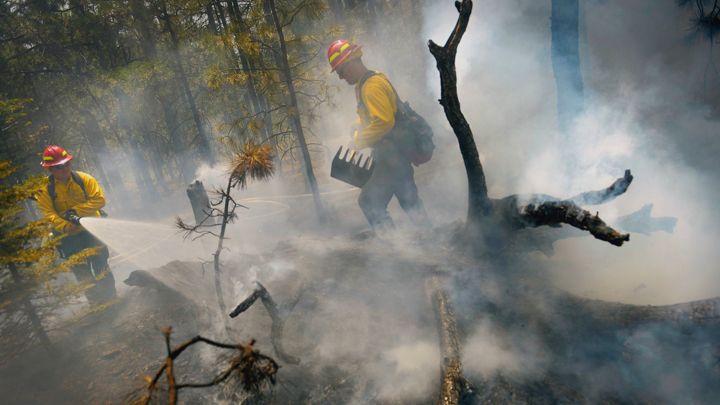By the end of the century, the woodlands of the Southwest will likely be reduced to weeds and shrubs. And scientists worry that the rest of the planet may see similar effects. Jeff Tietz, in a March 12 article for Rolling Stone with the title “The Fate of Trees: How Climate Change May Alter Forests Worldwide,” goes on to summarize an interview he had with alumnus Park Williams (PhD 2009):
In May 2011, a postdoctoral student at Los Alamos National Laboratory named Park Williams set out to predict the future of the dominant iconic conifers of the American Southwest — the Douglas fir, the piñon pine and the ponderosa pine. As the planet warms, the Southwest is projected to dry out and heat up unusually fast — few places will be more punishing to trees. Williams couldn’t rely on climate models, whose representations of terrestrial vegetation remain crudely unspecific. He needed a formula that could accurately weigh the variables of heat, aridity and precipitation, and translate atmospheric projections into a unified measure of forest health.
For decades, all over the planet, heat-aggravated droughts had been killing trees: mountain acacia in Zimbabwe, Mediterranean pine in Greece, Atlas cedar in Morocco, eucalyptus and corymbia in Australia, fir in Turkey and South Korea. A year earlier, a group of ecologists had published the first global overview of forest health. They described droughts whose severity was unequaled in the “last few centuries” and documented “climate-driven episodes of regional-scale forest die-off.” They couldn’t prove causality, but if the warming climate was responsible, they warned, “far greater chronic forest stress and mortality risk should be expected in coming decades.”
From a tree’s perspective, excessive heat may be as deadly as lack of water. To photosynthesize, a tree opens pores in its leaves called stomata and inhales CO2. Solar-charged chemical reactions then transform the CO2 into carbohydrates — the raw stuff of leaves and wood. During this process, a fraction of the tree’s internal water supply evaporates through its stomata, creating the negative pressure that pulls water from the soil into the tree’s roots, through its trunk and up to its canopy. But heat juices the rate at which trees lose moisture, and that rate escalates exponentially with temperature — so small temperature increases can cause a photosynthesizing tree to lose dangerous amounts of water. “Forests notice even a one-degree increase in temperature,” says Williams.
In the death scenario, the sky sucks water from the leaves faster than it can be replaced by water in the soil, and the resulting partial vacuum fatally fractures the tree’s water column. If a tree closes its stomata to avoid this, shutting down photosynthesis, it risks starvation. Ultimately, the tree’s cellular chemistry will fail, but it will often die before that, as its defenses fall; the complexly toxic sap that repels predatory insects dries up. Many insects can detect diminished sap levels within tree bark by scent — they smell drought stress and pheromonally broadcast news of deteriorating tree health. Other defenses – against microbes, for example — may also be compromised. A hotter climate generally means more insects. It also means more, and more intense, wildfires.
Williams amalgamated a millennium’s worth of data — the most comprehensive record of forest health ever assembled. Documenting the lives of 10,000 trees, the record spanned the years 1000 to 2007. From it, Williams derived a “forest-drought stress index” (FDSI), the first-ever holistic metric of atmospheric hostility to trees. In a 2013 paper titled “Temperature as a Potent Driver of Regional Forest Drought Stress and Tree Mortality,” Williams predicted that by the 2050s, the climate would turn deadly for many of the Southwest’s conifers. By then, he wrote, “the mean forest drought stress will exceed that of the most severe droughts in the past 1,000 years.”
The current climate was testing his conclusion even as Williams was reaching it. In 2000, the Southwest had entered an extreme, ongoing drought — the worst since a 20-year-long drought in the middle of the last century. Conditioned by near-record temperatures, dry soils and a lack of rain, the atmosphere stripped trees of moisture with exceptional force. “That extreme evaporative demand was a hint of what you’d see if you increased temperatures by a couple of degrees, as the models predict for the 2050s,” Williams told me. In terms of precipitation levels, the mid-century drought was worse, but humans had spent the intervening 50 years heating up the planet, and the drought of the 2000s has consequently killed many more trees.
“It was like looking through a telescope into the future to see how forests would respond, and it felt awful,” Williams says. “The result was totally unimaginable: wildfires, bark beetles, a huge reduction in forest growth, massive mortality. In the afternoons, I’d go on jogs on the trails outside my office and take mental inventory of who was dying and who was living. All over New Mexico, trees keeled over. It was like they’d been transported onto a new planet where climate is entirely different than what they were evolved for” (see the complete article here).
Editor’s note: Many thanks to Geography graduate student Elizabeth Garcia for suggesting this material. The article featuring Park as Elvis can be found here (and you might get a giggle out of his most famous costume as a grad student).




